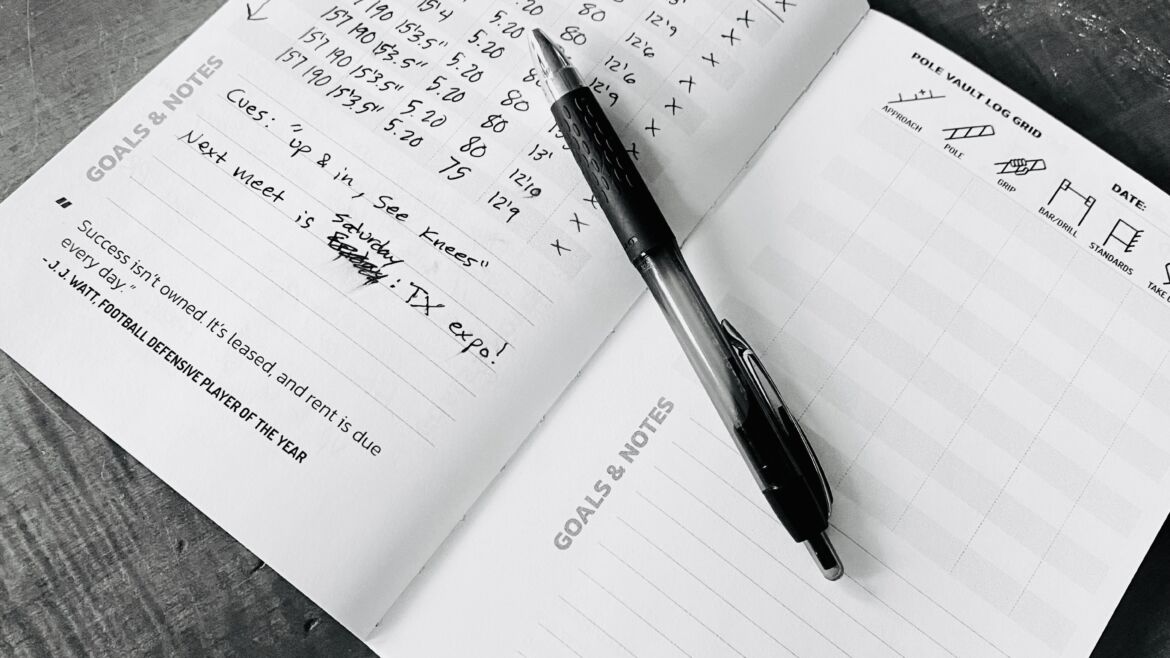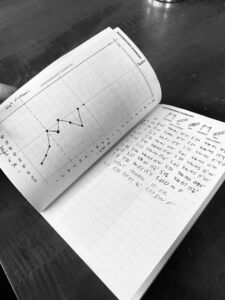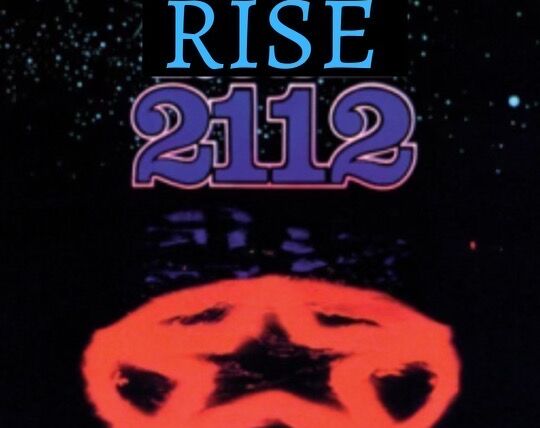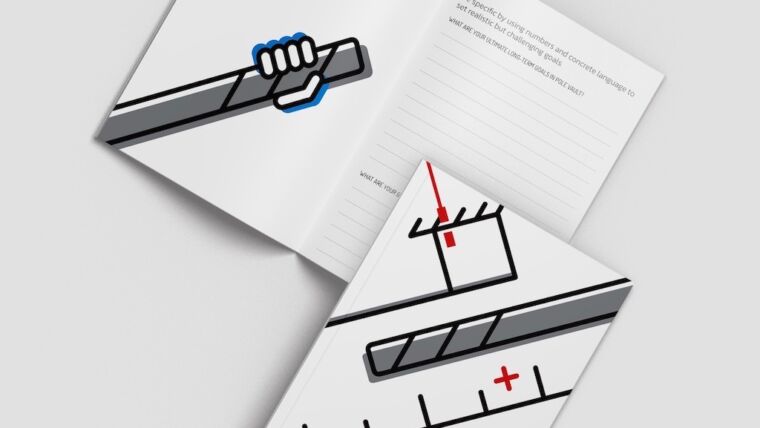When interviewing American record holder Sam Kendricks on episode twelve of the One More Jump Podcast, Sam talks about the importance of keeping a pole vaulting journal of his workouts and meets as a pole vault equipment for him to reflect on and track his improvement. I can also testify that logging or journaling my workouts helped produce my best years of pole vaulting. Journaling and keeping accurate pole vault training logs, becomes more and more prevalent when you look at the worlds best performers. Using something like the Pole Vault Log Book, helps you take conscious steps towards a better pole vaulting career. Data driven performance, and workout design, are such powerful pole vault equipment, and you can’t be data driven if you don’t have…DATA! With the new year approaching and a new track season on the horizon, let’s look at the importance of keeping a pole vaulting journal.
1. Documentation
So what is pole vaulting journal or logging your workouts/meets, and why is it important? Well, keeping a pole vaulting journal simply writing down specific, quantifiable, aspects of your training, along with other details of your workouts/meets, on a day to day basis, providing you with reliable data that you can reflect back on and analyze to help make improvements in the future. When I was vaulting, I would track and log everything. I had a pole vaulting journal, a lifting journal, a sprinting journal, and a nutrition journal. You should have seen the size of my workout bag!!! I still have all of those journals to this day. I can pick up one of those journals and say, “This journal right here won me a state championship, this journal won me two National Championships, and this one shows me how I rebuilt my body after a knee surgery”. There is such valuable information and lessons contained in those journals that I was able to apply to the next season, continually refining my craft in order to continue improving year after year. You can’t change what you don’t know.
2. Learning One’s Self
What you really are doing when you keep a journal of your workouts, is learning who you are and how you get better. What works for other people, will not always work for you, and by keeping a pole vaulting journal, you can look back on the trial and error process of finding what works for you. It is such valuable information!!! Not only is it valuable to you in your pole vaulting career right now, but these lessons and systems that are documented in your journals can be applied to other areas of your life in the future and better yet, be passed on to other people to help them on their journey. If you never take the time to log all of this information, you risk it being lost forever. Looking at those journals and reflecting on your own learning process is very powerful and can speed up your improvement in the future.
3. Proving Your Improvement
One of the main reasons that I took the time to journal was because I wanted proof that I was getting better. For years I would just have to hope I was getting better based on how I felt on a particular day, or what I would call emotional based progress. For example, here is a statement of a person who is basing their progress off of their current emotional state, “Well, I must be getting better, because I feel great today, and am having a great workout!” Unfortunately, judging your progress based solely on your emotional state can be a very rocky road and that “great day” you are having today, could be followed up by a terrible day tomorrow, and a statement like, “Well, I should just quit pole vaulting forever, because I am having a terrible workout today. I must not be getting any better”. In two days, you have gone from one end of the spectrum to the other. This type of judgement on your progress is completely unreliable and a story of fiction that is made up in your head. Your emotions are very hard to quantify. The person making these statements could be trending to have the best season of their lives, or could be completely tanking, but if you were to ask them, “Prove to me you are getting better”, or “Prove to me you are getting worse”, they would not be able to answer either question with any reliable data. Logging your workouts in a journal gives you tangible evidence of your improvement. When you have large amounts of data logged, you can grab your journal after a tough workout and really find out what direction you are going, and more often than not, you will probably come out of that reflection time being more confident about where you are at. This is why I find the feature of the Performance Summary in the Pole Vault Log Book to be so effective. It is very easy to see what direction you are going over time.
4. Was This a Good Workout or a Bad Workout?
Without the data in your journal, you have no grounds to say what a good workout is and what a bad workout is. Judging your workouts based only on what you think and feel is to subjective. What does a “good workout” consistent of? Maybe what you are thinking is a “good workout” is actually just an alright workout or a bad workout. You can’t really say if a workout is good or bad unless you are able to compare quantifiable data from one work out to another, or compare your goal targets for a workout to what you actually accomplished in that workout. Having hard, factual data in your journal will give you the ability to accurately judge your workouts as productive, or not productive, or as good or bad. Without that guiding data in your journal, you are just flailing around in your workouts hoping to get better without any guiding light. I don’t know about you, but I never wanted to just hope that my season ended up in a good spot. It was important for me to have goals and then proof that I was on the right path to achieving them.
5. Am I Hitting a Wall or am I Just Being Impatient?
If a vaulter is in the game for long enough, they will hit the proverbial “wall”. When athletes come to me and say they are getting worse, and you can sense that they may be hitting a wall, nine times out of ten this “wall” that they are hitting is just an emotional one and is not based on their performance data. If you are able to show them their improvement over time, their confidence can change in an instant. As a vaulter, it is very difficult to see improvement day to day. This is because, a lot of times improvement in the pole vault is in small, sometimes undetectable, increments. Also, vaulters are very good at forgetting the times that they made significant improvements like having a foot PR or getting on the biggest pole of their life. If a vaulter keeps a journal of their workouts/meets, a coach has the ability to tell them to grab their journal and flip to four months ago. More often than not, their numbers have improved. Then tell them to flip back eight months and the improvements are even more clear. Tell them to go back a year, and they are most likely going to have a hard time convincing themselves that they have not improved. If you are using the Pole Vault Log Book, you can use the Performance Summary Chart to easily reference this. If you don’t keep a journal, the ability to reference real change is not available to use during the difficult times. If you have ever found yourself in that situation or are a coach that deals with this a lot, you need to inject some quantifiable data into your pole vaulting journey.
6. Journals are like an Autopilot to Your Goals, Always Keeping You on the Right Track.
I think that everyone could agree on the importance of setting goals. We need to be setting daily, weekly, monthly, annual, and career goals. They need to be realistic, measurable, and then refined over time. They also need to have a road map, aka the pole vaulting journal you are going to do to get there. If you are setting a new goal, you and your coach should have a plan as to how you are going to see it come to fruition. How high will you need to grip to vault high enough to win that championship? How fast will you need to run to grip that high? What pole vault training methods will you use to improve your speed in order to run that fast? These are all important questions and it starts with you and your coach getting that goal and training plan on paper, your roadmap. Using a tool like the RISE Circles of Success, really helps you to dial in what your goals are and how you plan to get there.
Once you have that road map to follow, you will need to track your progress to that goal in your pole vaulting journal. If you are logging your workouts, you will have a much easier time assessing if you are on the right track or if you need to realign yourself with your goals. The only way this is possible is by analyzing our old friend…WORKOUT DATA!!! It is so important to sit down before practice and write down your goal for the day, log your progress towards that goal during your workout, and then spend a few minutes after practice checking to make sure that your workout data lines up with the roadmap to your goals. You are now on autopilot, just repeat this process day in and day out.
7. Reflection
One of my favorite things to do is look back on pole vault training journals of the past and reflect on what accomplishments came from each journal. I like to look back at them and see what new pole vault training techniques I was trying out and if those techniques produced good results or if they were complete BS. At the end of every season, I would take my journal and scour it for three big take aways that I would apply to my next season. This is actually the premise for the fun and interesting question that I always ask our guests on the One More Jump Podcast, which is, “If you could only pick three exercises that you could use exclusively for the rest of your pole vaulting career what would they be?”. This question forces you to really cut through the BS exercises you are wasting your time with and get to the meat and potatoes of what is actually moving the needle for you. I remember one year, I was experimenting with banded barbell squats and felt incredibly explosive and had a personal best that year, so that was carried into the next year. Another year I looked back into my journal and saw that I was spending over an hour warming up, because I was doing every warm up exercise known to man. It was really eating into my energy for the actual workout and making me perform worse, so that got trimmed down the next year. Year after year, these refinements would add solid layers of knowledge to what worked for me and helped me improve. I think reflecting and drawing conclusions from past pole vault training journals is the most efficient way for someone to improve.
8. Applying the lessons learned to other areas of your life
If you start logging your workouts, you will eventually end up with journals upon journals of very valuable data. The journals will be chock full of lessons and information about who you are and what works for you. The cool thing is that you can take this information and apply it to all areas of your life as you get older. I still keep journals to this day, but they are for different things outside of pole vaulting now. I have a logbook of all my meetings, to-dos, ideas, etc, of my first two years starting RISE Pole Vault, and I look back at them all the time. Sometimes I feel like RISE is not moving forward and improving at the rate I would like, so I grab a journal and see what we were up to a year ago and it always helps me to see that we are indeed moving forward. I also can look back on those old journals and flip to a random page to find an idea from that past that was forgotten, and then decide if that is something that would add value to the RISE Pole Vault Community. If I hadn’t kept a journal, those ideas could be lost forever.
Another awesome application for your journal collection is the ability to look back on your training and give the lessons you have learned to the next generation of vaulters. This is how we improve as a community, is by learning from the generation before us, refining what they taught us, and then passing it on to the next generation. For example, if an athlete is dealing with, let’s say, a back injury. It is hard to remember what your warm up was after you injured your back 20 years ago, but since this information has been logged, you can pull out that journal from when you went through a similar situation and see if that warm up helps them loosen their back up and effectively execute the day’s workout. Maybe you see an athlete dealing with a technical problem in their vault that you had when you were younger. You might pull out your journal and see that you did four weeks of a specific drill to fix the problem this athlete has. Boom, you may have just solved that problem for that athlete. You might say, “I remember how to fix these problems, I don’t need to write it down, I have a good memory”. I don’t doubt that, and many times I do not have to dive into the archives to fix a problem an athlete may have, but our memory about specific details like reps, sets, etc. can deteriorate over time, and those detailed bits of information could be just what you need to solve a problem quicker and more efficiently.
Well there you have it!
Eight really solid reasons why you should be journaling your pole vaulting workouts and meets. If you are not doing this you should really consider taking the time to at least try it out and see what you can learn about yourself and witness its effects on your improvement. Using something like the Pole Vault Log Book to log your workouts and meets can really be a game changer, so grab a spiral notebook, the notes app on your phone, or of course the beautifully designed and super functional Pole Vault Log Book, and start gathering data TODAY!!!!
Don’t know how to start logging your workouts or meets? Check out our blog How to Keep a Pole Vaulting Journal and learn how to track the proper data and how to analyze it.
RISE Higher.





